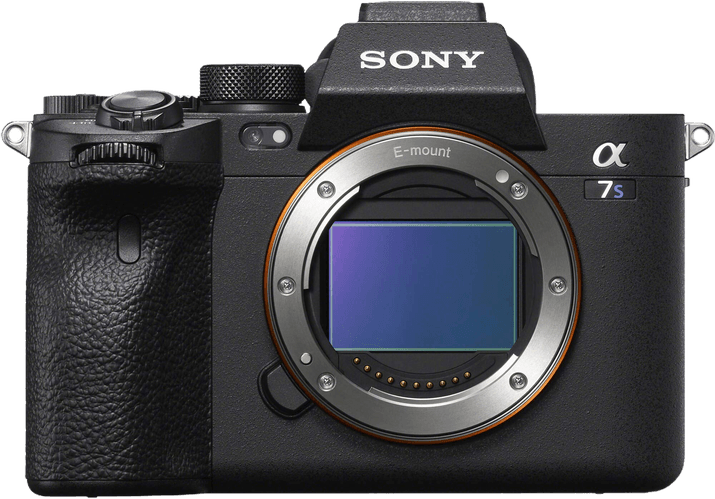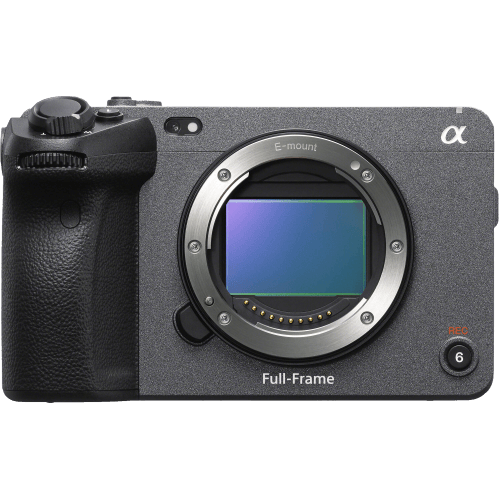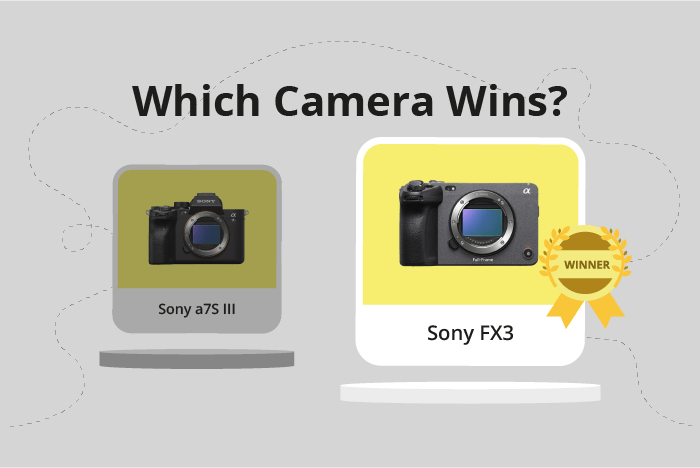Sony a7S III vs Sony FX3 Comparison
Sony a7S III

Sony FX3

The Sony FX3 takes the lead with a score of 75/100, slightly outperforming the Sony a7S III, which scores 74/100. Both cameras are mirrorless and were released in 2020 and 2021, respectively. They share similar dimensions, with the a7S III measuring 129 x 97 x 81mm and the FX3 at 129.7 x 77.8 x 84.5mm.
The FX3 has an advantage due to its lighter weight of 640g compared to the a7S III’s 699g. However, the a7S III is more affordable with a launch price of $3499, while the FX3 costs $3900.
Taking these factors into consideration, the Sony FX3 earns its higher score with a more compact and lighter design, making it a better option for those prioritizing portability. On the other hand, the Sony a7S III offers a more budget-friendly option without sacrificing much in terms of performance.
Sony a7S III vs Sony FX3 Overview and Optics
The Sony FX3 wins in the optics comparison with a score of 71/100, while the Sony a7S III scores slightly lower at 69/100. Both cameras share several specifications, such as 12.1 megapixels, 10 fps shooting speed, CMOS sensor type, Bionz XR processor, full-frame sensor size, and image stabilization.
The FX3’s advantage lies in its DXOMARK sensor score of 94, compared to the a7S III’s score of 86. This means the FX3 provides better image quality and low-light performance. Additionally, the FX3 has a Sony E lens mount, which offers a wider range of lenses compared to the Sony FE mount on the a7S III. This versatility allows the FX3 to adapt to various shooting scenarios more easily.
Despite its lower score, the a7S III still has its merits. It features a Sony FE lens mount, which is specifically designed for full-frame cameras. This means that the lenses used on the a7S III are optimized for its sensor size, potentially providing better image quality in certain situations. However, the difference in lens mount is not a major drawback, as both cameras are compatible with a wide array of lenses.
In comparing the optics of the Sony a7S III and the Sony FX3, the FX3 takes the lead due to its higher DXOMARK sensor score and lens mount versatility. However, the a7S III remains a strong contender with its full-frame optimized lens mount. Both cameras are equipped with impressive specifications, making them suitable for various photography and videography needs.
Sony a7S III vs Sony FX3 Video Performance
The Sony FX3 outperforms the Sony a7S III in video capabilities, boasting a higher video score of 91/100 compared to the a7S III’s 77/100. Both cameras share common specifications, such as 4K max video resolution, 3840 x 2160 max video dimensions, and a max video frame rate of 120fps. However, the FX3 surpasses the a7S III in certain aspects, making it the superior choice for videographers.
A key advantage of the Sony FX3 is its built-in time-lapse functionality, which the a7S III lacks. This feature allows users to create stunning time-lapse footage without the need for additional equipment or software, providing greater creative flexibility and convenience.
The Sony a7S III, while trailing behind the FX3 in video capabilities, still offers high-quality video performance. Its video score of 77/100 is respectable and can meet the needs of many users. However, it does not surpass the FX3 in any specific video-related specifications.
When comparing the video capabilities of the Sony a7S III and the Sony FX3, the FX3 emerges as the clear winner. Its higher video score and built-in time-lapse functionality set it apart from the a7S III, making it a more versatile and powerful tool for videographers. While the a7S III is still a strong contender in the realm of video performance, it does not offer any unique advantages over the FX3 in this area. For those seeking the best in video capabilities, the Sony FX3 is the recommended choice.
Sony a7S III vs Sony FX3 Features and Benefits
The Sony a7S III and Sony FX3 both have a feature score of 83 out of 100, indicating that these cameras are quite similar in terms of features. They share several specifications, including a 3-inch screen size, 1,440,000-dot screen resolution, touchscreen capabilities, flip screen, and the absence of GPS. Additionally, both cameras have WIFI and Bluetooth connectivity.
Despite their similarities, the Sony a7S III has some advantages over the Sony FX3. The a7S III is known for its exceptional low-light performance, making it an excellent choice for photographers and videographers who often work in challenging lighting conditions. It also offers more autofocus points, providing greater flexibility and precision when focusing on subjects.
On the other hand, the Sony FX3 boasts a more compact and lightweight design, making it a more portable option for those who need to travel with their camera frequently. The FX3 also features a top handle with additional mounting points and controls, which can be beneficial for videographers who require easy access to audio and other accessories.
In terms of features, both the Sony a7S III and Sony FX3 are strong contenders, with their shared specifications making them suitable for various photography and videography needs. The a7S III excels in low-light performance and autofocus capabilities, while the FX3 offers a more portable design and additional mounting options. Ultimately, the choice between these two cameras will depend on the specific requirements and preferences of the user.
Sony a7S III vs Sony FX3 Storage and Battery
The Sony a7S III and Sony FX3 have identical storage and battery scores, both achieving a 76/100. These cameras share several specifications, such as the number of memory card slots (2) and the types of memory cards accepted (SD/SDHC/SDXC – UHS-II compatible, CFexpress Type A). Additionally, both cameras utilize the same battery type (NP-FZ100) and offer USB charging.
Battery life is also the same for both cameras, with each providing 600 shots per charge. As there is no clear winner in this category, both cameras perform equally well in terms of storage and battery capabilities.
Despite the tie in this category, the Sony a7S III and Sony FX3 each offer reliable storage and battery options, making them suitable choices for various photography and videography needs. Users can expect consistent performance from either camera when considering storage and battery features.
Alternatives to the Sony a7S III and Sony FX3
Are you still undecided about which camera is right for you? Have a look at these popular comparisons that feature the Sony a7S III or the Sony FX3:

